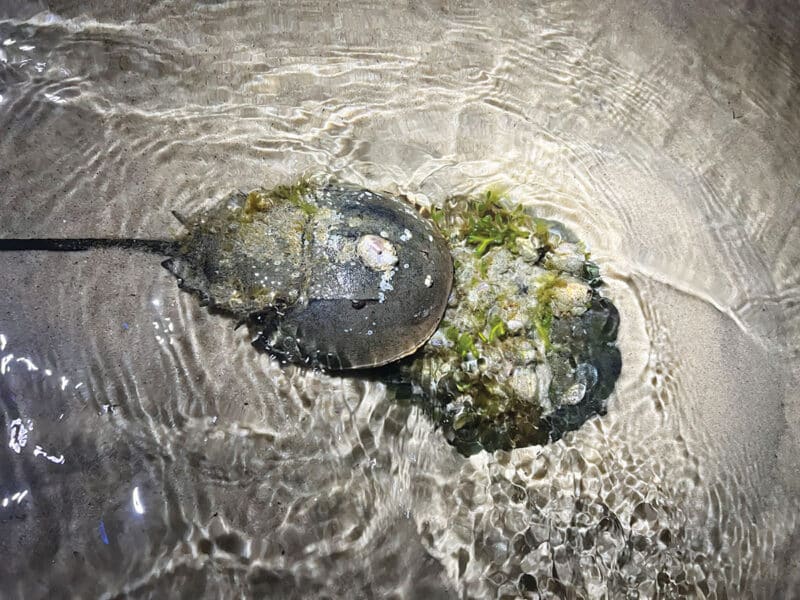by Suzanne Daub
From 9 to 10 pm next Tuesday night, June 21, scientists from Nantucket’s Maria Mitchell Association (MMA) will lead an expedition to find and study members of a species that is older than the dinosaurs right here on our island beaches, under stars that are even older.
Estimated to be more than 400 million years old, the Atlantic horseshoe crab (Limulus polyphemus) can be found from Nova Scotia to the Gulf of Mexico, and every year they travel to shorelines to spawn. When the tide is high, horseshoe crabs make their way through the surf to mate and to lay their eggs at night. A female horseshoe crab can deposit approximately 4,000 eggs in clusters, and she’ll do this several times, laying up to around 20,000 eggs in a single night and up to 100,000 during each meeting season.
June 20 is International Horseshoe Crab Day, and June 21 is the Summer Solstice, making this Tuesday an ideal time for the Maria Mitchell Association to offer another of their fun interdisciplinary excursions. This Horseshoe Crab Solstice Walk will be led by MMA Director of Astronomy Dr. Regina Jorgenson and MMA Aquarium Director Jack Dubinsky.
According to Dubinsky, participants will search for horseshoe crabs and learn about their biology. Dr. Jorgenson will explain the physics of lunar phases, seasons, and tides, and help participants identify the constellations above. With Dubinsky, she will discuss how marine organisms, including horseshoe crabs, may use Earth’s magnetic field to navigate in the ocean.
For more than a decade, MMA scientists have been conducting horseshoe crab surveys along Monomoy Beach. “We survey them during breeding season— on the full and new moons—and report the data [to a regional organization] to help manage the fishery…” explained Dubinsky. “Most recent data suggest the horseshoe crab population here is stable. Compared to pre-industrial era, there are far fewer, but their population does not appear to be continuing to decline.”
With a Last Quarter moon on the solstice this year, it should be a dark night, explained Dr. Jorgenson. “We will see Polaris and start to see the Summer Triangle… and to the south we’ll see Scorpio and Sagittarius. To the north we’ll see the Big Dipper, Little Dipper, and Cassiopeoia.” Three days after the Solstice Horseshoe Crab Walk, MMA is planning a special Open Night for a “celestial stakeout” to see five planets that will be visible in alignment: Mercury, Venus, Mars, Jupiter, and Saturn.
“This walk is a rare opportunity: not often do marine biologists and astronomers collaborate on a walk… to relate these two different fields to an animal that is so interesting… horseshoe crabs are a species that reaches astronomical time scales,” Dr. Jorgenson commented.
It’s difficult to predict exactly where they’ll turn up, but if you miss the Horseshoe Crab Solstice Walk and want to see horseshoe crabs on Nantucket on your own, Dubinsky recommends looking along Madaket Beach and Eel Point. “They appear to come closer to the beach at the night high tide.” If you see one dug into the sand and not upside down, leave it alone. If you find a horseshoe crab that is upside down, flip it over and put it back in the water. “Horseshoe crabs can survive a tidal cycle outside of the water if they are not upside down,” Dubinsky explained. “If their gills dry out, then they cannot breathe.”
Maria Mitchell Association is an island-based science organization that is interdisciplinary and devoted to sharing their expertise and love of learning with all who wish to join them. Sign up for Tuesday’s Horseshoe Crab Solstice Walk at mariamitchell.doubleknot.com/event/horseshoe-crab-solstice-walk/2914686
Fun Facts about Horseshoe Crabs, courtesy of the Ocean Conservancy:
Horseshoe crabs get their name from their horseshoe-shaped exoskeleton, called a carapace. Because their carapace does not grow with them, these creature s molt up to an average of 16 times before reaching maturity.
Their physiology has remained largely unchanged over time, which is why they’re often referred to as “living fossils.”
Horseshoe crabs are much more closely related to arachnids like spiders and ticks than to true crabs.
Some of their favorite foods are sea worms, mollusks, and crustaceans.
Their tails, called telsons, aren’t poisonous or venomous; they’re mainly used to st e er and flip themselves over in case they get stuck on their backs.
Flap-like structures near their abdomen, called book gills, enable horseshoe crabs to breathe underwater … but sometimes, they use them for the goofier purpose of swim ming upside-down. It’s mainly the youngsters that engage in this behavior.
With 9 eyes in total along with various light receptors near their telson, horseshoe crabs have insanely good vision.



